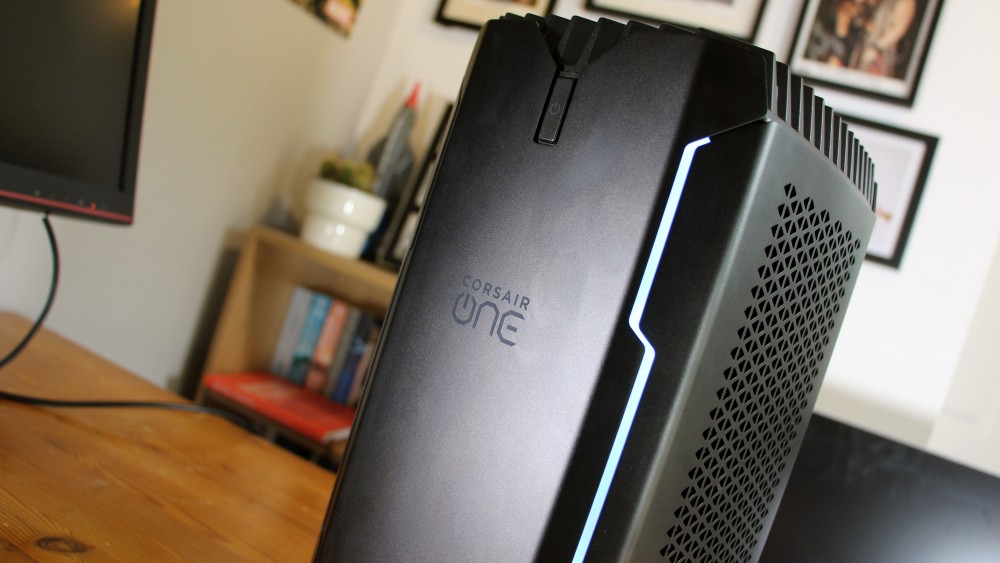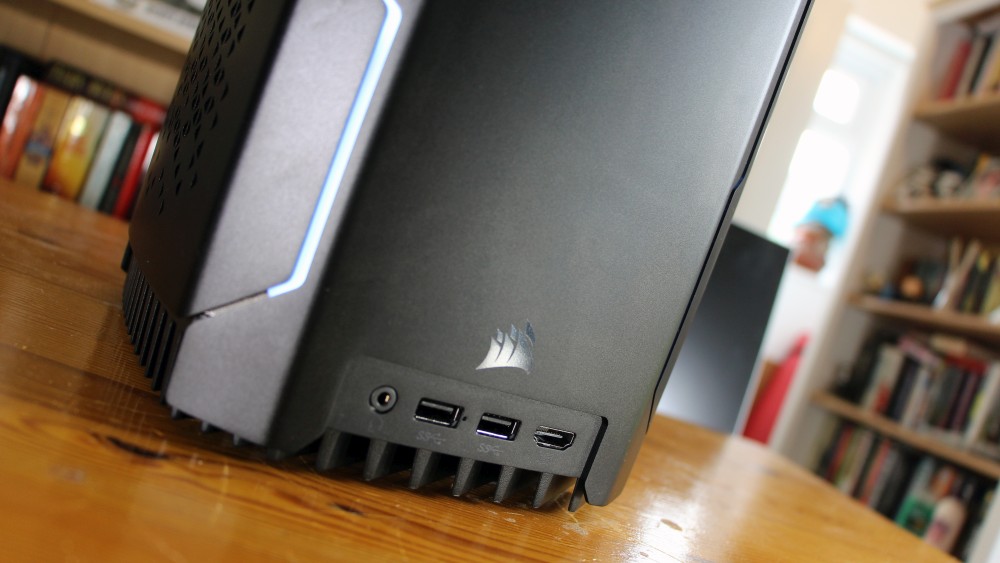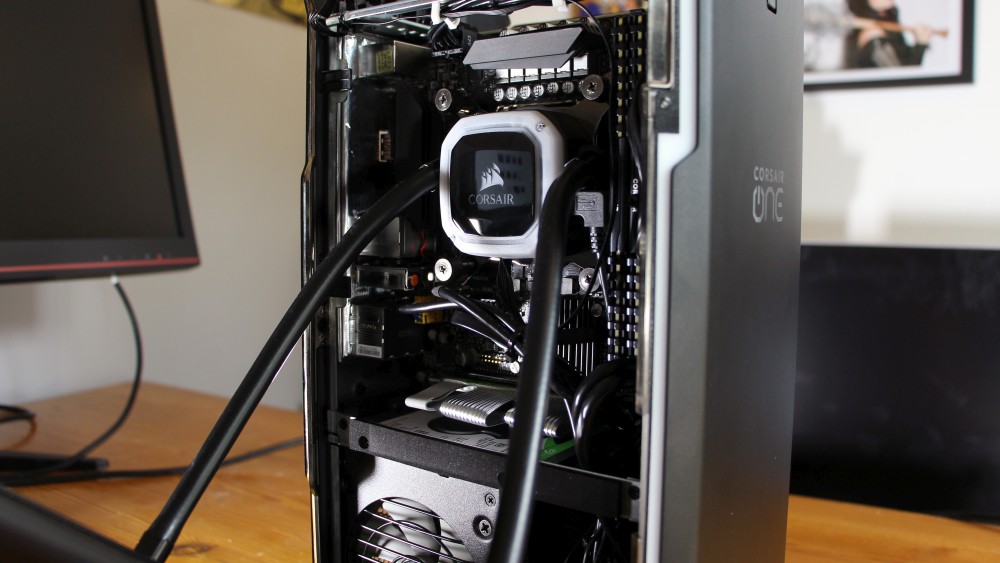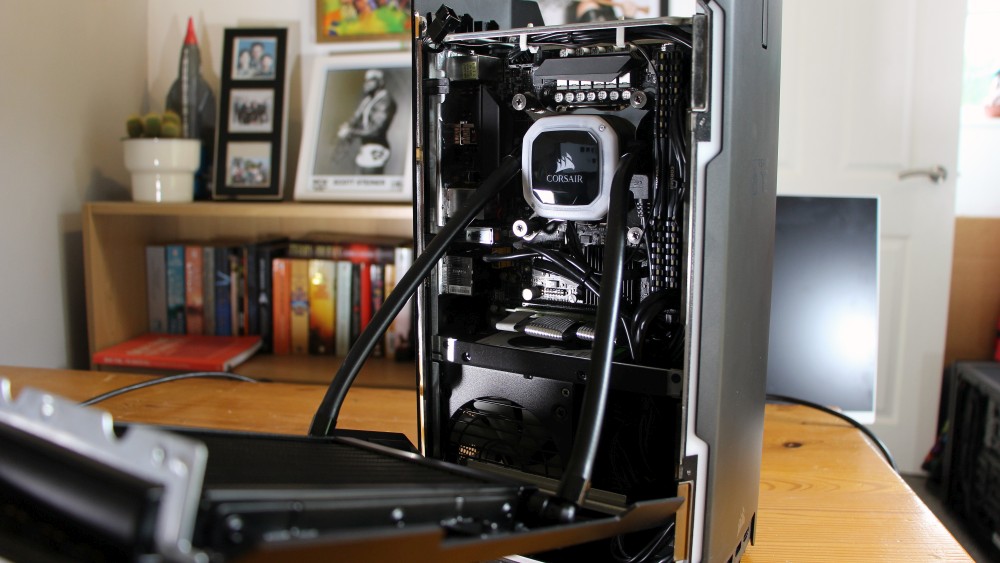Corsair One i160 review: A meaty mid-range workstation
Huge power inside a tiny package. Can the Corsair One i160 handle the heat?
Although its multi-threaded performance can't match machines with beefier workstation-grade chips, the Corsair One i160 is a fantastic mid-range unit for light to moderate workloads, with a small footprint, smart internal design and quiet running.
-
+
Powerful enough for many creative and work applications; Impressively quiet; Improved design
-
-
Pricier than competitors; Few upgrade paths; Middling multi-thread performance







Corsair is marketing the latest iteration of its One desktop as a machine for professionals as well as gamers - and it certainly has enough processing and graphical power to scythe through tough productivity software.
It's expensive, though, at 2,833 exc VAT, and the One faces strong competition from plenty of conventional workstations.
Corsair One i160 review: Design
The Corsair One has been around since 2017, and it's always been small, near-silent and incredibly powerful. It's always looked fantastic, too; the Corsair is built from rock-solid aluminium, with two bands of RGB LEDs down the front and a smart power button. It's subtle and stylish enough to grace any office.
Corsair's machine looks better than many desktop workstations, and it's smaller too. It's just 380mm tall and 172mm wide, and it only weighs 7.38kg. All of the Corsair's rivals are larger, conventional machines. The Dell Precision 5820 is taller, deeper and weighs 15kg, and the Armari Gravistar BR-850A 24c TR4 uses a BeQuiet enclosure that's 523mm tall and 514mm deep. The InterPro IPW-CL also uses a full-sized enclosure.
The Armari is the only rival that costs more than the Corsair - it has a 24-core AMD CPU and tips the scales at 3,295 exc VAT. The Dell and InterPro machines are around 400 cheaper than the Corsair.
The Corsair's high price is partly justified by its design. It takes plenty of work to build compact PCs that can handle high-end components, and this latest iteration needed several internal changes to cope with a new generation of hardware.
Older versions crammed the big components into the bottom of the rig. The mini-ITX motherboard was installed on one side, with the PSU, with the graphics card on the other side of the machine. That was sufficient, but it wasn't perfect. Cables trailed untidily around the interior, making most of the components hard to reach and hindering airflow.
Sign up today and you will receive a free copy of our Future Focus 2025 report - the leading guidance on AI, cybersecurity and other IT challenges as per 700+ senior executives

This year's model moves things around. The power supply is still at the bottom, but it's in its own compartment. The motherboard moves to the top, while the graphics card still occupies the other side. The motherboard's higher position means it's not obscured by cables, so components can be accessed. The separate PSU compartment means cables are better-hidden and well-routed, which benefits the whole interior.
There are other, less obvious internal changes. The CPU and GPU are chilled by dedicated water-cooling units in the side panels. The CPU cooler has been made smaller with no reduction in performance, which cleverly allows the PSU to have its own source of cool air. That means it doesn't have to rely on the Corsair's sole 140mm fan, which sits in the roof of the machine.
The Corsair remains relatively easy to open. A button on the back allows the top to lift free, and two screws on either side release the side panels. Once that's done, the motherboard, memory and storage are accessible. If you need access to the main components, you'll have to remove the cooling units which is a more involved job.
The front ports move from the top to the bottom of the redesigned chassis. You get two USB 3.1 Gen 1 connectors, an audio output and an HDMI port. On the rear, you get two faster USB 3.1 Gen 2 connectors - one full-size, one Type-C. Rear display outputs include three DisplayPort connectors, but there's no rear-mounted HDMI.
Corsair's machine is an example of fantastic design, but its rivals are better in some areas. All three of those larger machines have more upgrade room and space to work, and the Dell is easier to get inside and service than anything else mentioned here.
Corsair One i160 review: Hardware
The layout isn't the only thing that's changed with the new unit; the Corsair One has also had a complete component upgrade. The model reviewed here has an Nvidia GeForce RTX 2080 Ti. It's one of Nvidia's most powerful consumer cards, with 11GB of GDDR6X memory and 4,352 stream processors. It also has a small overclock for a little extra pace.
It uses the Turing architecture - which means you get ray-tracing for improved lighting and particle effects and deep-learning super-sampling for AI-powered anti-aliasing. The GPU supports a maximum resolution of 7,680 x 4,320, and it supports OpenCL 1.2, OpenGL 4.6, Vulkan 1.1 and DirectX 12. The new features aren't supported in many applications, but they're sure to be adopted by more developers over time. As this is a consumer GPU, you don't get ISV certification, but there's no denying the huge raw power on offer.

The processor is an eight-core Hyper-threaded Intel Core i9-9900K, which uses the company's latest Coffee Lake-S architecture - a consumer architecture which nevertheless delivers better base and boost clock speeds compared to workstation chips with more cores.
The i9-9900K's sixteen addressable threads are ample for multi-tasking, Office applications, photo and video work and database tools. However, it doesn't have the core count to handle CAD design software, engineering tools and other applications that are designed to thrive on proper workstation CPUs like the Armari's 24-core AMD Ryzen Threadripper 2970WX CPU.
The Corsair includes a generous 32GB of DDR4 memory, although its 2,666MHz speed could be better. Still, that's enough for most work applications. You also get Windows 10 Home on a 512GB Samsung PM961 SSD alongside a 2TB hard disk. The storage is capacious, and that SSD is not slow, but there are minor issues here: Samsung's latest 970-branded consumer drives are faster, and the hard disk's rotational speed of 5,400rpm is sluggish.
The parts connect to a modified MSI Z370I Gaming Pro Carbon AC motherboard. It's got dual-band 802.11ac wireless and Gigabit Ethernet built in, but it doesn't support more than 32GB of memory. Of course, it is a mini-ITX motherboard, so upgrade room is limited. If you're after more memory slots, extra PCI connectivity or more storage options then a full-size ATX system will be better.
Corsair One i160 review: Performance
In our performance benchmarks, the Corsair racked up an overall score of 299, with scores of 176, 296 and 342 in the image encoding, video encoding and multi-tasking tests, respectively. That puts it ahead of Dell's Precision on all fronts - which isn't entirely surprising given that the Precision uses a Xeon W-2125 processor with half the number of cores, as well as a less powerful GPU - but behind the Armari and InterPro for most tests. The former rig's 24-core CPU makes it better at multi-tasking, and the latter has a Core i9-9900K with faster memory.
However, a look at Cinebench reveals how far the Core i9-9900K is behind proper workstation chips. The Corsair's score of 1,854cb is fine - ahead of the Dell and almost level with the InterPro. But it's not even half as good as the 4,651cb recorded by the Armari and its 24-core CPU.
The tough SPECviewperf benchmarks illustrate the Corsair's strengths and weaknesses. It outpaced the Dell in almost all tests - Again, no surprise given the Dell's weaker components. The Corsair's RTX 2080 Ti was faster than the Armari's Radeon GPU in the 3dsmax-06, maya-05 and creo-02 tests, so 3D animation and modelling will clearly work well on the Corsair - along with photo and video applications. However, the Corsair delivered a poor score in the snx-02 benchmark, and was behind the Armari in the catia-04 tests. CPU-intensive tasks like rendering, engineering and product design will be slower.
And then, finally, there's the tough Blender Gooseberry render test. In this benchmark the Corsair took 2,011 seconds to render a scene - but the 24-core Armari managed it in 899 seconds.

The Corsair offers impressive performance levels in mainstream applications, and its thermal performance is even better. The CPU and GPU peaked at solid temperatures of 72C and 64C, and there were no throttling issues. The CPU ran consistently at 4.7GHz and at 4.2GHz with all cores at load, and the GPU rattled along at 1,870MHz.
Impressively, the Corsair is essentially silent when handling numerous work applications. When the components were really stressed, the Corsair produced a low rumble - but it's so quiet that you won't notice the noise in an office.
Corsair One i160 review: Verdict
The Corsair One i160 is a superb PC. The revised design is neater and more accessible, and it helps the i160 deliver a performance boost without thermal issues. The Corsair is smaller and better-looking than all of its rivals - and with better build quality.
Corsair's machine serves up decent power considering its size. It's got enough CPU ability for mainstream design, productivity and Office tools and it'll handle multi-tasking too. The GPU is great for photo and video editing, design work and 3D animation.
However, you'll need workstation-level components to smoothly run the toughest rendering, engineering and CAD software. The small chassis also means there's basically no upgrade room, and you can't add more memory. The GPU isn't ISV certified, and there could be a broader selection of ports and display outputs.
The Corsair One i160 is the middle machine from the range, but it's undoubtedly expensive. The Corsair One i140 costs 2,375 exc VAT and includes an i7-9700K processor that has eight cores but no Hyper-Threading alongside an RTX 2080 graphics card. The more expensive Corsair One Pro i180, meanwhile, costs a mighty 3,983 exc VAT, and it's the more intriguing alternative option. It has a 12-core i9-9920X that offers more grunt for creative work and database tools. It retains the RTX 2080 Ti, and upgrades the storage to a 1TB SSD.
Nevertheless, plenty of offices will be better served by a small, quiet PC with loads of power than by a huge tower - and the Corsair certainly fits that brief. It's expensive, but the Corsair One i160 is an excellent option if you need lashings of mainstream work ability in a small package.
Verdict
Although its multi-threaded performance can't match machines with beefier workstation-grade chips, the Corsair One i160 is a fantastic mid-range unit for light to moderate workloads, with a small footprint, smart internal design and quiet running.
Processor: 3.6GHz Intel Core i9-9900K
RAM: 32GB 2,666MHz DDR4
Graphics: Nvidia GeForce RTX 2080 Ti 11GB
Storage: 512GB Samsung PM961 SSD, 2TB hard disk
Operating system: Windows 10 Home 64-bit
Optical: N/A
Connectivity: Dual-band 802.11ac, Bluetooth 4.2, Gigabit Ethernet
Ports: Front: 2 x USB 3.1 Gen1, 1 x audio, 1 x HDMI; rear: 1 x USB 3.1 Gen 2, 1 x USB 3.1 Gen 2 Type-C, 2 x USB 3.1 Gen 1, 2 x USB 2, 1 x Gigabit Ethernet, 1 x PS/2, 1 x optical S/PDIF, 5 x audio
Dimensions: 173 x 200 x 380mm (WxDxH)
Weight: 7.38kg
Warranty: 2yr RTB
Mike Jennings has worked as a technology journalist for more than a decade and has been fascinated by computers since childhood, when he spent far too long building terrible websites. He loves desktop PCs, components, laptops and anything to do with the latest hardware.
Mike worked as a staff writer at PC Pro magazine in London for seven years, and during that time wrote for a variety of other tech titles, including Custom PC, Micro Mart and Computer Shopper. Since 2013, he’s been a freelance tech writer, and writes regularly for titles like Wired, TechRadar, Stuff, TechSpot, IT Pro, TrustedReviews and TechAdvisor. He still loves tech and covers everything from the latest business hardware and software to high-end gaming gear, and you’ll find him on plenty of sites writing reviews, features and guides on a vast range of topics.
You can email Mike at mike@mike-jennings.net, or find him on Twitter at @mikejjennings
-
 ‘1 engineer, 1 month, 1 million lines of code’: Microsoft wants to replace C and C++ code with Rust by 2030 – but a senior engineer insists the company has no plans on using AI to rewrite Windows source code
‘1 engineer, 1 month, 1 million lines of code’: Microsoft wants to replace C and C++ code with Rust by 2030 – but a senior engineer insists the company has no plans on using AI to rewrite Windows source codeNews Windows won’t be rewritten in Rust using AI, according to a senior Microsoft engineer, but the company still has bold plans for embracing the popular programming language
By Ross Kelly Published
-
 Google drops $4.75bn on data center and energy firm Intersect
Google drops $4.75bn on data center and energy firm IntersectNews The investment marks the latest move from Google to boost its infrastructure sustainability credentials
By Nicole Kobie Published
-
 OpenAI says prompt injection attacks are a serious threat for AI browsers – and it’s a problem that’s ‘unlikely to ever be fully solved'
OpenAI says prompt injection attacks are a serious threat for AI browsers – and it’s a problem that’s ‘unlikely to ever be fully solved'News OpenAI details efforts to protect ChatGPT Atlas against prompt injection attacks
By Nicole Kobie Published
